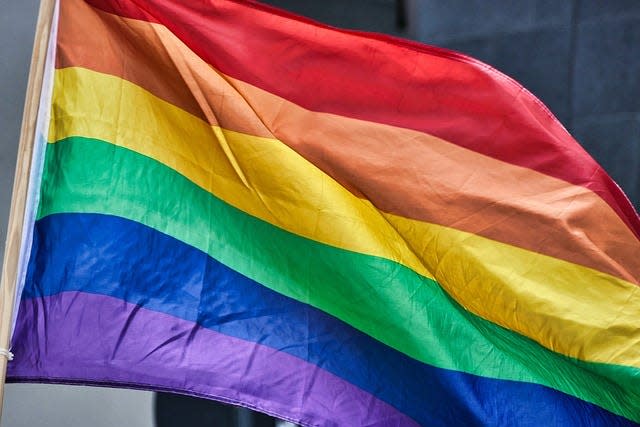Rainbow flag meaning: A brief history lesson on how the Pride flag came to be
Since its creation in 1978, the pride flag has become a universal symbol for the LGBTQ+ community. It represents visibility and hope and reflects the diversity within the LGBTQ+ community.
While the flag is easily recognized, its history may not be as well-known to everyone. Did you know the current rainbow flag is an updated design of the original?
Here is a history lesson on how the pride rainbow flag came to be and the meaning behind its colors.
What do the colors of the Pride flag mean?
Each of the pride flag's six rainbow colors has a unique meaning:
Red: Life
Orange: Healing
Yellow: Sunlight
Green: Nature
Blue: Serenity
Purple: Spirit

When is Pride Month 2024? How the celebration of LGBTQ+ identities came to be.
The history of the Gilbert Baker pride flag
In the 1970s, Harvey Milk – the first openly gay elected official in California – tasked activist Gilbert Baker to design a symbol of hope for the gay community.
"Harvey Milk was a friend of mine, an important gay leader in San Francisco in the ’70s, and he carried a really important message about how important it was to be visible," Baker said in an interview with the Museum of Modern Art in 2015. "A flag really fit that mission, because that’s a way of proclaiming your visibility, or saying, 'This is who I am!'"
The original Pride flag had eight stripes, each symbolizing:
Hot pink: Sex
Red: Life
Orange: Healing
Yellow: Sunlight
Green: Nature
Turquoise: Magic
Indigo: Serenity
Purple: Spirit
Prior to the rainbow flag, the pink triangle was used as a symbol for the LGBTQ+ community, according to Baker. In Nazi Germany, people were forced to wear pink triangles. While the symbol was reclaimed, the community wanted a new symbol.
"We needed something beautiful, something from us," Baker said in the MoMA interview. "The rainbow is so perfect because it really fits our diversity in terms of race, gender, ages, all of those things."
The original pride flag was flown for the first time at the San Francisco Gay Freedom Day Parade celebration on June 25, 1978, the History Channel reports.
Pride 2024: Latest news and events honoring LGBTQ rights.
How did the Pride flag come to be?
The original flag was made by hand, but as they started to be mass-produced, the hot pink stripe was removed due to manufacturing difficulties, the New York Times reports.
Parade organizers also wanted the rainbow to have an even number of stripes so to split and line the street along parade routes. Baker then removed the turquoise stripe, replacing it for blue, the History Channel reports.
More Pride Flags explained
Progress Pride Flag | Lesbian Pride Flag | Transgender Pride Flag | Bisexual Pride Flag | Pansexual Pride Flag | Asexual Pride Flag | Intersex Pride Flag | Gender Identity Flags
Just Curious for more? We've got you covered
USA TODAY is exploring the questions you and others ask every day. From "What are the colors of the Intersex Pride flag?" to "When was gay marriage legalized in the U.S.?" to "What does deadnaming mean?" − we're striving to find answers to the most common questions you ask every day. Head to our Just Curious section to see what else we can answer.
This article originally appeared on USA TODAY: Pride flag colors, explained: What's behind the rainbow symbol?

 Yahoo Lifestyle
Yahoo Lifestyle 
